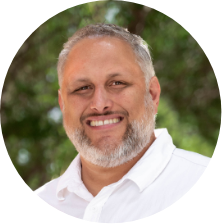
Interestingly, as I was wandering around in the dimly lit world of psychoanalysis, a pressing question continued to nag at me until I finally decided it was worth addressing. If the interior world of the mind is constructed through representations based on embodied experiences with real, external objects, how does that real, embodied information get encoded so that the mind can use it? After all, we don’t have “fake” experiences. The external world is real, and we as material beings in that real world interact with the real world every day through a process that is biological. In other words, what is the raw neural data we are drawing from to form our representations, what kind of data is it, and how does it get processed? To answer this, I had to look at how the brain works.
A helpful way to think about the brain is to imagine a train with its engine, freight car, and caboose. The engine is the spinal cord, brain stem, and cerebellum, or what is sometimes called the lower reptilian complex. It is the first receptor of signals being sent all throughout the body and is responsible not only for our physiological homeostasis but also the instinctive responses such as fight, flight, or freeze. The reptilian brain is the vital link between what the body experiences, or perceives, and the parts of the brain that attempt to make sense of those perceptions and experiences. The brain is not simply the matter housed in the skull; it is fundamentally linked to the entire body. As psychiatrist Dan Siegel wrote: “When we use the term ‘brain,’ we can now see it makes no sense in our conceptualizations to separate this skull-based structure from the body as a whole.”1
The freight car is the limbic system, which is made of two primary parts: 1) the amygdala, which receives information from the brainstem (engine) and translates it into emotion that puts the person into a heightened state of awareness, and 2) the hippocampus, which synthesizes neural information and translates it into the memories that form our personal narratives (it puts puzzle pieces together). The brainstem and limbic system do not function in our awareness but are subconscious reactions to information received from the body (Spiderman’s “spidey-sense” comes to mind). Our limbic system allows us to react in a dangerous situation without knowing what is actually happening.2 Bessel van der Kolk describes the lower reptilian complex coupled with the limbic system the “emotional brain,” given the visceral nature of its processes. It is the foundation of every decision we make in life.
Finally, the caboose is the neocortex, which consists of the left and right hemispheres, the various outer lobes that control the five senses and motor function, and most importantly, the prefrontal cortex (PFC). If information is integrated properly, the PFC takes what it is given and works to assign it meaning. It gives us the capacity for abstract thought, awareness of self, and moral judgments. It allows us to think about what we’re thinking about, make informed decisions, and even “play” with the information to discover new or deeper meaning.
During the gestation period of a healthy human, the brain develops from the bottom up, from the lower reptilian complex to the limbic system to the neocortex. Not surprisingly, this is also how it functions. Just as a train is driven by the engine, information from the nervous system all throughout the body is delivered via the spinal cord to the brainstem and cerebellum, which passes it along to the limbic system, which sends it to the neocortex to try and make sense out of it. We are a bottom-up kind of creature.3
Also during the gestation period of a healthy human, the right side of the brain, the hemisphere responsible for integrating sensory data, processing and regulating emotions, nonverbal communication, and image mapping develops first. In fact, the left side of the brain, the hemisphere responsible for logic, speech, and linear thought, does not substantively “turn on” until age two, and even then it consistently lags behind the right hemisphere process, so the experiences we have and the embodied indicators (emotions) those experiences produce are constantly dragging our logical left brain behind them. The left brain is literally constantly following behind the right brain trying to figure out what’s actually happening. For a thorough and excellent treatment of this phenomenon, see Iain McGilchrist’s outstanding book The Master and His Emissary.4 Just as the brain develops from bottom to top, the cortical hemispheres develop from right to left, which, not surprisingly, is how they function.5 We are right to left kind of thinkers. Bottom-up, right-left kind of experiential thinking creatures.
One of the primary functions of our brains is to “map” the world we live in, something that results in what is known as autobiographical memory, which draws from the combination of both implicit and explicit memory.6 Implicit memory forms through repeated experience, which fires neurons that begin to wire together and form a neural pathway that subsequent firings are more likely to take, like ruts in a road. This is known as Hebb’s Axiom: Neurons that fire together, wire together.7 During the first few years of life these neural pathways shaped from experiences are the initial raw data we draw from to begin constructing our internal representations of the external world. And here is a critical point: Implicit memory does not require conscious awareness for it to be recalled and used. When an experience triggers our implicit memory, the representations we’ve created will activate and, without us knowing it, cause us to relive a past experience as if it is our present reality.8 As the brain develops, so will our ability to take all of this information and make logical sense out of it, but our left-brain logical processing will always trail behind the implicit map of our holistic, affective, experiential knowledge. “No matter how much insight and understanding we develop, the rational brain is basically impotent to talk the emotional brain out of its own reality.”9
When the left hemisphere does finally activate, we begin to take encoded memory and place it in a linear, coherent narrative able to be consciously recalled. This is known as “explicit memory,” the type of memory most people think of when they hear the word “memory.” The part of the limbic system responsible for explicit memory is the hippocampus, which acts as a kind of puzzle piece assembler, taking the raw data of experiential implicit memory and integrating it into both semantic memory, or factual story (i.e. It is true the sky is blue), and episodic memory, or the recall of past events (i.e. I got a race car track for Christmas one year).10 When the hippocampus is functioning unimpeded, this physiological process extends implicit neural fibers throughout the cortical region and connects them to one another, filling in the gaps where needed. Siegel summarizes this well:
The hippocampus does a very special thing. It takes these building blocks of experience that are encoded in memory, these implicit basic puzzle pieces, and the hippocampus links them together and literally . . . extends these neural fibers out throughout the cortex and then takes these separated elements of implicit memory and constructs an interwoven jigsaw puzzle assembly, so that you see a larger picture: first episodic for autobiographical memory recall . . . [then] a generalization of these repeated episodes . . . to a larger conglomeration that has the formal term “autobiographical,” meaning we’re now beginning to weave a general picture . . . of ourselves across time.11
But the hippocampus does not always function unimpeded. If someone is formed in an environment where repeated experiences are negative or even dangerous, instead of hippocampal integration, the brain stem triggers the limbic system to activate the amygdala, which triggers the adrenal gland to release the hormone cortisol throughout the body as a defense mechanism against the dangers of the environment. If the amygdala is consistently firing, it degrades the ability of the hippocampus to assemble information properly. Instead of completing the puzzle, the suppressed hippocampal activity ends up leaving large gaps in the information passed on to the right brain. If the body of implicit memory built over time is largely negative, the gaps in information will be filled with powerful memories driven by a fight, flight, freeze response. In this case, negative experiences can get “stuck” in the right side of the brain because there is not enough integrated information to pass along to the left side of the brain. One might have an awareness that something is off, but is largely unaware of why and will struggle to assign language to this awareness, which keeps it from integration into a coherent narrative. Until these negative experiences are brought to the level of awareness in a safe environment that allows the amygdala to relax and encourages hippocampal activity, these powerful experiences will color all subsequent data, filling gaps with unrelated negative emotion.
As a recent father for the fourth time, I am watching my youngest child use her God-given hardware to map her experiences in a holistic, affective way, and lay the foundation from which she will experience and make sense of her world.12 She is seeing, hearing, feeling, tasting, and smelling objects for the first time. As time goes on she will assign verbal symbols (names) to those objects and experiences and naturally organize them into a lens she will view the world through. The large object who feeds and nurtures her will become “mother,” and the even larger object who supports and protects her will become “father.” Just like all humans, she is hardwired with a fundamental need and enormous capacity to attach to these two objects, which we will cover in the next article.13

